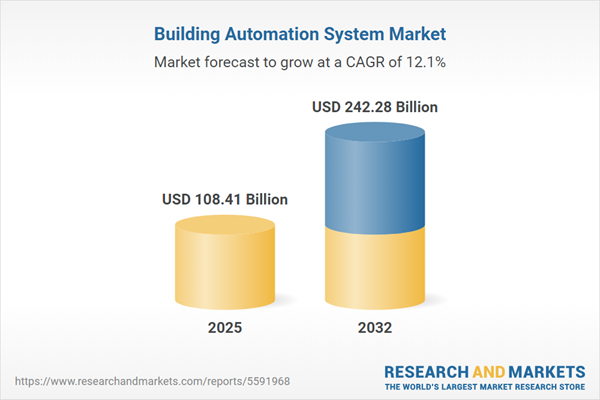Speak directly to the analyst to clarify any post sales queries you may have.
The building automation system market is transforming how organizations manage facilities, prioritizing connected infrastructure, real-time controls, and data-driven sustainability practices. As automation gains momentum across commercial and industrial sectors, senior leaders are rethinking strategies to optimize performance and ensure long-term resilience.
Market Snapshot: Growth, Trends, and Market Size in Building Automation Systems
The building automation system market grew from USD 97.28 billion in 2024 to USD 108.41 billion in 2025. It is projected to maintain a robust compound annual growth rate of 12.08%, reaching USD 242.28 billion by 2032. This expansion reflects accelerated demand driven by digital transformation, energy efficiency mandates, and the need for integrated operational control. Organizations are integrating building automation systems to streamline facility management, address evolving regulatory frameworks, and pursue sustainability objectives while safeguarding occupant safety and comfort.
Scope & Segmentation: Strategic Coverage Across Solutions and Regions
- Component Types: Actuators, controllers, detectors, sensors, consulting services, integration services, building automation software, construction software
- System Types: Building management systems, HVAC control systems (including humidity control devices, thermostats), lighting control systems (dimmers, occupancy sensors), remote monitoring systems, security & access control systems (biometric readers, surveillance cameras)
- Technology Modalities: Wired standards (BACnet, LonWorks, Modbus); wireless solutions (Bluetooth, Wi-Fi, Zigbee)
- Solution Types: Closed loop systems, open loop systems, semi-loop systems
- Deployment Modes: Cloud-based, on-premises
- Building Types: New constructions, retrofit buildings
- End Use Sectors: Commercial applications (education, healthcare, hospitality, offices, retail), industrial (manufacturing, oil & gas, pharmaceuticals), residential
- Geographies Covered: Americas (United States, Canada, Mexico, Brazil, Argentina, Chile, Colombia, Peru), Europe, Middle East & Africa (United Kingdom, Germany, France, Russia, Italy, Spain, Netherlands, Sweden, Poland, Switzerland, United Arab Emirates, Saudi Arabia, Qatar, Turkey, Israel, South Africa, Nigeria, Egypt, Kenya), Asia-Pacific (China, India, Japan, Australia, South Korea, Indonesia, Thailand, Malaysia, Singapore, Taiwan)
- Key Companies Profiled: ABB Ltd., Bosch Sicherheitssysteme GmbH, Bajaj Electricals Limited, Building LogiX, Carel Industries S.p.A., Carrier Global Corporation, Cisco Systems, Inc., Crestron Electronics, Inc., Delta Electronics, Inc., Emerson Electric Co., Fuji Electric Co., Ltd., General Electric Company, Hitachi Ltd., Honeywell International Inc., Huawei Technologies Corporation, Hubbell Inc., Ingersoll Rand, Johnson Controls International PLC, KMC Controls, Inc., Koninklijke Philips N.V., Larsen & Toubro Limited, Lutron Electronics Co. Ltd, Mitsubishi Electric Corporation, Schneider Electric SE, Siemens AG, Trane Technologies PLC
Key Takeaways: Strategic Insights Shaping Market Direction
- Digitalization is reshaping facility operations through integration of remote monitoring, predictive maintenance, and real-time performance tracking.
- Organizations are balancing modular hardware selection with intelligent software, optimizing capital expenditures while future-proofing lifecycle performance.
- Sustainability imperatives are reinforcing the adoption of self-optimizing controllers and solutions aligned with emerging environmental regulations.
- Interoperability and cybersecurity have become key concerns, motivating adoption of standardized protocols and robust data protection frameworks.
- Regional adoption patterns reveal that retrofit projects prioritize system flexibility, while new constructions favor end-to-end automation adoption from design stage.
- Innovation pipelines, supported by cross-sector partnerships, continue to advance user-centric design and accelerate deployment of turnkey automation solutions.
Tariff Impact: Supply Chain, Procurement, and Innovation Strategies
New tariff measures in the United States are increasing costs for imported automation components, encouraging firms to re-evaluate sourcing strategies and streamline procurement. Organizations are responding by exploring cost mitigation through value engineering, nearshoring, and diversification of supplier bases. This shift also encourages investment in domestic R&D to reduce dependence on global supply chains and to ensure agility in future policy environments.
Methodology & Data Sources
This report employs a rigorous mixed-method approach. Secondary research draws from industry publications, technical documents, and case studies, while primary research is based on interviews and workshops with equipment manufacturers, software providers, system integrators, consultants, and facility managers. Triangulating multiple data sources ensures accurate, unbiased insights for stakeholders at every stage of decision-making.
Why This Report Matters
- Offers actionable intelligence for aligning technology investments with emerging industry standards, regulatory shifts, and ESG priorities.
- Enables senior leaders to benchmark against regional and segment peers, validate procurement strategies, and anticipate risks linked to evolving supply chain dynamics.
- Delivers clear, validated data to support both strategic planning and operational improvements for stakeholders in both new construction and retrofit scenarios.
Conclusion
The building automation system market is advancing through technological convergence, regulatory momentum, and a focus on resilient, sustainable operations. Informed strategic decisions today will drive operational excellence and long-term value for facility stakeholders.
Additional Product Information:
- Purchase of this report includes 1 year online access with quarterly updates.
- This report can be updated on request. Please contact our Customer Experience team using the Ask a Question widget on our website.
Table of Contents
3. Executive Summary
4. Market Overview
7. Cumulative Impact of Artificial Intelligence 2025
Companies Mentioned
The companies profiled in this Building Automation System market report include:- ABB Ltd.
- Bosch Sicherheitssysteme GmbH
- Bajaj Electricals Limited
- Building LogiX
- Carel Industries S.p.A.
- Carrier Global Corporation
- Cisco Systems, Inc.
- Crestron Electronics, Inc.
- Delta Electronics, Inc.
- Emerson Electric Co.
- Fuji Electric Co., Ltd.
- General Electric Company
- Hitachi Ltd.
- Honeywell International Inc.
- Huawei Technologies Corporation
- Hubbell Inc.
- Ingersoll Rand
- Johnson Controls International PLC
- KMC Controls, Inc.
- Koninklijke Philips N.V.
- Larsen & Toubro Limited
- Lutron Electronics Co. Ltd
- Mitsubishi Electric Corporation
- Schneider Electric SE
- Siemens AG
- Trane Technologies PLC
Table Information
| Report Attribute | Details |
|---|---|
| No. of Pages | 181 |
| Published | November 2025 |
| Forecast Period | 2025 - 2032 |
| Estimated Market Value ( USD | $ 108.41 Billion |
| Forecasted Market Value ( USD | $ 242.28 Billion |
| Compound Annual Growth Rate | 12.0% |
| Regions Covered | Global |
| No. of Companies Mentioned | 27 |









